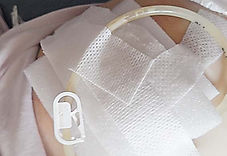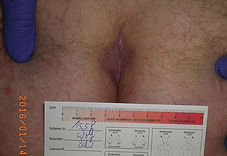Fistulas and surgical wounds
Texts and images (c) Ligamed
Case report 1 - Wound treatment with LIGASANO® for inflamed PEG puncture site
Patient data and anamnesis:
2-year old girl from Lower Bavaria, Z.n. epileptic encephalopathy, a PEG plant due to refusal to eat was carried out on 05.09.2016 in Augsburg. First daily bandage change, cleaning with NaCl, supply with Metalline.
Inflammation of the injection site, pus focus visible, swollen. Presentation at the paediatrician. Recommendation: Change of dressing twice a day, cleaning with Octenisept, if necessary antiobiotic ointment in case of further deterioration. From 14.09.2016 Start of treatment with LIGASANO®: Cleaning twice daily with Octenisept, application of a sterile LIGASANO® slotted compress 7.5 x 7.5 x 1 cm.

Fig. 1: 16.09.2016 cleaning with Octenisept, application of antibiotic ointment for two days, dressing change once a day with LIGASANO® white sterile 7.5 x 7.5 x 1 cm

Fig. 2: 23.09.2016 Significant improvement, further dressing change once a day with LIGASANO® white sterile 7.5 x 7.5 x 1 cm, ointment supply ended.

Fig. 3: 10.10.2016 Minimal inflammation still present, further dressing change once a day with LIGASANO® white sterile 7.5 x 7.5 x 1 cm

Fig. 4: 23.10.2016 complete healing of the inflammation.

Fig. 5: 23.10.2016 Further use of the slit compress made of LIGASANO® white sterile 7.5 x 7.5 x 1 cm
Conclusion:
A very simple, inexpensive and allergen-free supply. The slit compresses made of LIGASANO® white dressing material are still used as pressure protection and prophylaxis.
Author: Barbara Hinz, nurse, wound expert, from Landshut, German
(c) Ligamed
Padding of hoses, catheters and tubes
Prefabricated slit compresses
Case report 2 - Wound treatment with LIGASANO® for abscessing sinus pilonidalis
Patient data / anamnesis:
33 years, male, abscessing sinus pilonidalis (recurrence), condition after excision, open wound treatment in November 2014 with abscess left lateral to the penis root, condition after excision, open wound treatment in April 2013 with abscessing sinus pilonidalis, condition after pit-picking, nicotine abuse. In September 2015 an excision of the abscessing pilonidal sinus was performed. Histological findings: Pilonidal sinus with florid and chronic fibrosing inflammation. Pretreatment in the clinic: Several times daily showering of the wound. Treatment with compresses was performed as wound filler and wound covering. A Fixomull® stretch polyacrylate adhesive plaster was used for fixation.
The patient presented for the first time on 27 October 2015 at our WZ® Wound Centre with severe pain in the area of the wound and wound environment under drug pain therapy with Cox-2 inhibitor - Arcoxia 90 mg in the morning. The wound environment showed no signs of irritation. There was a slight bleeding in the area of the wound margin.
The wound depth was 2.5 cm up to the subcutis. 80% of the wound bed was covered with fibrin, which was strongly attached to the wound bed. Isolated granulation islands appeared. A wound odour was present when the dressing was removed. A wound swab was taken at first admission with the finding of colonisation by Corynebacterium sp. and coagulase-negative staphylococci. On 29.03.2016 a control smear was taken, in which only isolated erythrocytes, leukocytes and epithelial cells were found. The local therapeutic wound treatment in the WZ® Wound Centre was carried out as follows:
Wound cleaning: Wet-dry phase with a wound cleansing solution based on a singlet oxygen, NaOCl (ActiMaris®).
Wound filler: Tamponade with LIGASANO® Wound strip 300 x 2.5 x 0.4 cm, white, sterile.
Wound coverage: Zetuvit® plus10 x 20 cm. Fixation with Mefix® 11 cm x 10 m.
Frequency of dressing changes daily, with exudate removal 3-4 x weekly. Relatives were instructed on dressing changes. In the context of the reduction of patient relatives, particular emphasis was placed on hygienic measures, nicotine refusal, pain medication intake and nutritional substitution. A seat cushion was prescribed as an aid to reduce or distribute pressure.

Fig. 1: 27.10.2015

Fig. 2: 17.11.2015

Fig. 3: 03.12.2015

Fig. 4: 22.12.2015

Fig. 5: 14.01.2016
Fig. 1: 27.10.2015: Wound size 8.37 cm2, wound depth 2.5 cm, pain according to NRS: 8/10
Fig. 2: 17.11.2015: Wound size: 4.35 cm2. Wound contraction visible, epithelial tissue in the wound area is stable. Wound depth: 1.8 cm. Due to the local therapeutic measure with the LIGASANO® wound dressing used, white, sterile, pain reduction could be achieved according to NRS: 3/6.
Fig. 3: From 03.12.2015 a change in therapy was performed. Wound cleansing was left untreated, the absorber was replaced by a LIGASANO® wound dressing. Fixation remained. Frequency of dressing changes increased to 4x weekly.
Fig. 4: 22.12.2015: Wound size 0.31 cm2, wound depth 0.1 cm, pain medication discontinued since 14.12.2015.
Fig. 5: 14.01.2016: Stable, epithelialized wound, recurrence-free until August 2016.
Summary / Conclusion:
The LIGASANO® Wound Tape 300 x 2.5 x 0.4 cm, white, sterile shows a very good adaptation to the wound contours without exerting pressure on the wound. Granulation and wound contraction took place very quickly with simultaneous reduction of exudation and significant pain reduction.
Author: Heidi Jodl, health and nurse, AZWM®, head of the WZ® Wound Center Augsburg
(c) Ligamed

